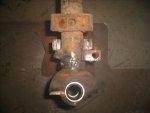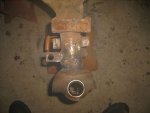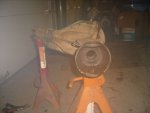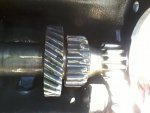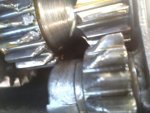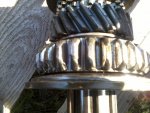Cut-and-turn on a Dana 27 closed knuckle axle
I performed the cut-and-turn on my closed knuckle dana 27 axle. From my reseach most people have done this more often on the open knuckle dana 44 axles. From what I have found it is not real common for the closed knuckle alxes. Just what I have found.
The question: Why is a cut-and-turn needed?
The answer: As I understand it from my research, on the older Scouts the front axles were set up SUA (spring under axle) and with 0* caster angle. When doing a SOA (spring over axle) the pinion angle is turned up so that the u-joint and driveline angles stay about where they are supposed to be. This changes the caster to a negative caster. On my axle it was at -10*. As I understand everything (and I do not know everything) the caster should be around 6* to 10* positive. I have included a picture as a reference for the caster angles. Please see first picture. In order to change the caster from the -10* to 6* to 10* a cut-and-turn is needed.
What a cut-and-turn intails.
This is what I did on my axle. On my axle, the closed "C" is on a tube that is pressed inside the actual axle tube and then welded at the edge of the "C" the the outer portion of the axle tube. I first ground down a "V" all the way around the end of the axle tube where the factory weld was. Once I had a good "V" ground down, I took a cut off wheel and cut around the axle until I had a crack showing all the way around. This way I knew the outer portion was seperated from the axle tube. I then took a big hammer and beat the "C" until I had the caster angle where I wanted it. I took extensive measurements before, during, and after to make sure the I had everything where it should be. I will have to look at my notes tomorrow as they are with my axle. I believe I set it up with 7* of caster. I then tack welded the "C" to the axle tube. I then double and triple checked my measurements. Once I was sure that I had the caster set where I wanted it, I took and welded the "C" to the axle tube. I made 4 complete welds all the way around the axle to get everything filled back up. I made good and sure of my ground as well as having the "C" and tube good and clean. I then repeated the process on both sides. I made darn certain that both sides were matching. The second picture is of the driver's side after welding. The third picture is of the passenger side after welding. The fourth picture is a view from the passenger side showing the knuckle in relation to the pinion. I will post up a few other pictures of before it was welded, as I do not have them on my computer at this time.
Hope all that made sense to everyone. If there is something that someone does not understand let me know specifically what it is and I will try to explain it better. Well that is a basic cut-and-turn on a Dana 27 front axle.
Ray
I performed the cut-and-turn on my closed knuckle dana 27 axle. From my reseach most people have done this more often on the open knuckle dana 44 axles. From what I have found it is not real common for the closed knuckle alxes. Just what I have found.
The question: Why is a cut-and-turn needed?
The answer: As I understand it from my research, on the older Scouts the front axles were set up SUA (spring under axle) and with 0* caster angle. When doing a SOA (spring over axle) the pinion angle is turned up so that the u-joint and driveline angles stay about where they are supposed to be. This changes the caster to a negative caster. On my axle it was at -10*. As I understand everything (and I do not know everything) the caster should be around 6* to 10* positive. I have included a picture as a reference for the caster angles. Please see first picture. In order to change the caster from the -10* to 6* to 10* a cut-and-turn is needed.
What a cut-and-turn intails.
This is what I did on my axle. On my axle, the closed "C" is on a tube that is pressed inside the actual axle tube and then welded at the edge of the "C" the the outer portion of the axle tube. I first ground down a "V" all the way around the end of the axle tube where the factory weld was. Once I had a good "V" ground down, I took a cut off wheel and cut around the axle until I had a crack showing all the way around. This way I knew the outer portion was seperated from the axle tube. I then took a big hammer and beat the "C" until I had the caster angle where I wanted it. I took extensive measurements before, during, and after to make sure the I had everything where it should be. I will have to look at my notes tomorrow as they are with my axle. I believe I set it up with 7* of caster. I then tack welded the "C" to the axle tube. I then double and triple checked my measurements. Once I was sure that I had the caster set where I wanted it, I took and welded the "C" to the axle tube. I made 4 complete welds all the way around the axle to get everything filled back up. I made good and sure of my ground as well as having the "C" and tube good and clean. I then repeated the process on both sides. I made darn certain that both sides were matching. The second picture is of the driver's side after welding. The third picture is of the passenger side after welding. The fourth picture is a view from the passenger side showing the knuckle in relation to the pinion. I will post up a few other pictures of before it was welded, as I do not have them on my computer at this time.
Hope all that made sense to everyone. If there is something that someone does not understand let me know specifically what it is and I will try to explain it better. Well that is a basic cut-and-turn on a Dana 27 front axle.
Ray


